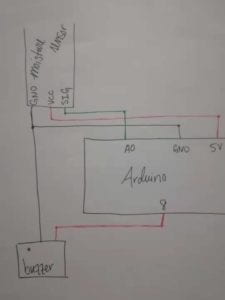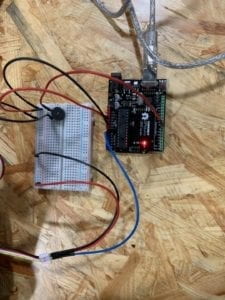Recitation 3: Sensors (Moisture sensor)
Diagram:

The circuit:

Components:
- Arduino
- USB
- Breadboard
- Jumper cables
- Moisture sensor
- Buzzer
Process:
My partner and I had two different kinds of issues in building this circuit:
- Circuit issues: In terms of the circuit-building, we had some confusion about the yellow and white wires of the moisture sensor. We also had a moment of confusion about connecting the buzzer, as we had plugged it into the wrong port. These were not big issues, though. Most importantly, after this recitation I have a better idea of how to read schematics and view my own circuits.
- Coding issues: We had a lot of trouble with the coding. Figuring out how to make the sensor read was actually quite easy, as was making the buzzer sound in response to the sensor. This was too simple, so we decided we wanted the buzzer to play a melody instead of just sounding off — we had trouble making this happen. We took code from the “toneMelody” sample, but had several issues fitting it in: we forgot to add the tab which defined the tones, forgot to replace the port in the original code with the correct port for our buzzer, and forgot which parts of the code needed to go in the looped section. After a lot of trial and error we found a way to make the code work.
Questions:
1. We intended to assemble a circuit which would play a small melody after sensing an increase in moisture. I can see this kind of circuit being used in lots of different ways. The most obvious example to me would be using this in a weather-related context, or with a humidifier which alerts its user when a certain humidity is reached.
2. This recitation definitely showed me how code can be like a recipe. Code is a set of instructions that will be followed exactly, like strictly following a recipe. What really sticks with me is the fact that combining different kinds of code is like combining two recipes — rather than simply following one and then following the other, the two must be fit together to form an amalgamated product.
3. The development of computer technology and new media seems to have an effect on how we understand our tools. Rather than working with hands-on items, the tools we use in our daily life are becoming more and more removed from our own ways of understanding. We don’t speak the same “language” as our technology anymore . Basically, we find ways to interact with things which do not seem natural to us (and which many of us do not fully understand).